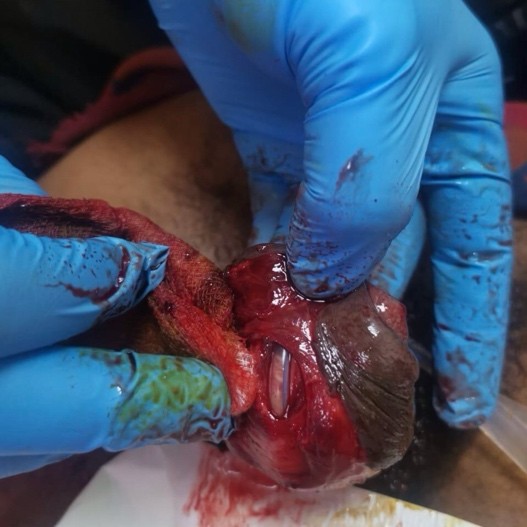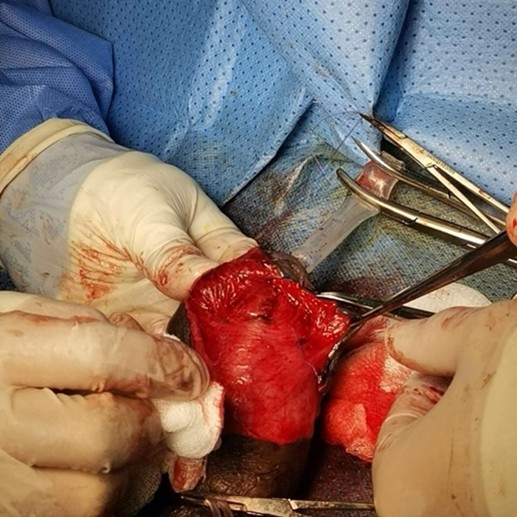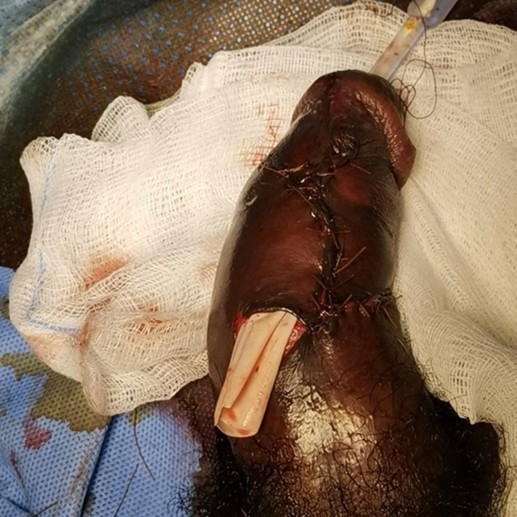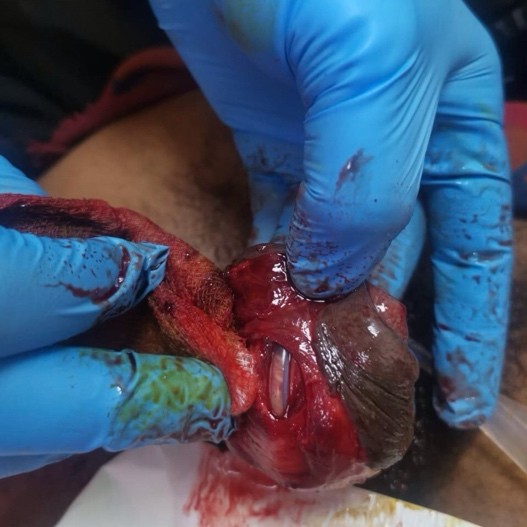Volume 5, Issue 8
August 2025
Adult Urethral Repair After Incomplete Urethral Injury Following a Dog Bite – A Rare Case Report
Ahmed A. Alghareeb, Luluwh A. Alhadeeb, Basmah Z. Al Ghanim, Abdulilah F. Alrasheed, Shadi S. Abu Alsaud, Ali M. Al Abandi
DOI: http://dx.doi.org/10.52533/JOHS.2025.50801
Keywords: penile dog bite, adult genital trauma, urethral injury, surgical repair, infection prophylaxis, degloving injury, case report
Background: Dog bites are prevalent in clinical practice and can lead to significant local and systemic infections, including tetanus and rabies. Injuries to the external genitalia, particularly the penis, are rare due to anatomical protection and defensive mechanisms, yet they require systematic management.
Case Presentation: We present a case of a 41-year-old male who sustained a dog bite to the penis, resulting in a degloving injury, a longitudinal injury to the corpora spongiosum, and an incomplete urethral tear. Initial management included broad-spectrum antibiotics, tetanus and rabies prophylaxis, followed by surgical repair under spinal anesthesia. The patient underwent successful urethral repair and skin closure, with no postoperative complications observed. He was discharged with oral antibiotics and scheduled for outpatient follow-up.
Conclusion: This case highlights the successful management of a complex penile dog bite through prompt medical intervention, appropriate surgical repair, and effective infection prophylaxis. It underscores the importance of a systematic approach in managing such rare injuries and contributes to the limited literature on adult penile dog bites. Long-term follow-up is essential to monitor for potential complications.
Introduction
Dog bite incidence rates are estimated at approximately 740 cases per 100,000 population annually across Europe and the United States (1). An average of 2.6 per 100,000 cases require hospitalization. In the United States, annual mortality from dog attacks is 7.1 per 100 million population, with children under 10 years of age disproportionately affected, accounting for 57% of all fatalities (2). External genitalia’s injuries caused by dog bite, particularly to the penis, are very rare if we conduct a comparison with cases of injury due to dog bites. Majority of cases in the literature review of penile dog bites are reported in the pediatric age group, possibly because proportionately less mobilization of infants or due to the envy developed between the dog and children within the family.
Epidemiological data from the Pasteur Institute of Casablanca a specialized rabies control center, demonstrates that dog bites predominantly affect highly vascularized anatomical regions, including critical areas such as the head, neck, torso, and genital areas (3, 4).
While canine-related injuries are prevalent, traumatic genital injuries from dog attacks represent an exceptionally uncommon occurrence. The spectrum of such injuries can be extensive, potentially causing significant anatomical damage ranging from localized tissue trauma to near-complete genital destruction. These incidents are predominantly documented in regions with limited infrastructure and higher populations of uncontrolled, unvaccinated canines (5).
Dogs are well-known for being attracted to the perineal area not only of other dogs, but other species as well, the reason for this attraction might be dog coprophagia (6). The attractiveness of the external genitalia and perineum to the animal to bite could be owing to being undressed in front of the animal, or immobilisation and defenceless as in case of pediatric victims.
Dog bites and all other bites can transmit infection either local infection by normal flora of the biter’s mouth or systemic infection e.g tetanus and rabies. Although only 15-20% of dog bites develop infection, these infections are typically polymicrobial, with Pasteurella species being the predominant organisms. The most frequent aerobic pathogens include Pasteurella multocida and Staphylococcus aureus, representing 20-30% of infected cases (7). Anaerobic organisms, such as Bacteroides fragilis and Fusobacterium species, are also frequently implicated (7).
As a result, many protocols and guidelines are developed for treatment and prophylaxis in these cases by local authorities and international medical associations.
The delicate nature of penile reconstructive surgery poses substantial technical obstacles, even for surgeons with extensive operative experience. Prophylactic administration of broad-spectrum antimicrobial agents significantly mitigates potential infectious sequelae, with patients receiving prompt medical intervention and exhibiting minimal initial contamination demonstrating favorable outcomes through primary surgical reconstruction (5).
The literature has a lack of reported cases of penile dog bite with skin degloving, corpora injury and partial urethral injury in adult male, this study describes the injury, and how it was managed. From the first step into the emergency room, till the patient is discharged home and follows up in the clinic after surgical repair. The comprehensive details are mentioned including the initial assessment, wound care, perioperative management, intraoperative surgical repair of the injury and post-operative care to the wand and follow up.
The aim of this case report is to detail the comprehensive management of a complex adult penile dog bite injury, highlighting the importance of prompt intervention, appropriate surgical techniques, and infection prophylaxis. By documenting this case, we seek to provide a valuable reference for clinicians dealing with similar rare injuries, emphasizing best practices in emergency care and long-term management.
Case Presentation
A 41 years old unemployed Saudi male with free medical and surgical history presented to the emergency department with chief complain of a dog bite on the penis around 1 hour before arrival. The patient was vitally stable, presented with degloving injury in the ventral aspect of the shaft of penis, 3-4 cm longitudinal injury of corpora spongiosum and incomplete urethral tear that involved a part of corpra cavernosa (Figure 1). The patient denied dysuria, urethral discharge, or associated cutaneous manifestations such as rash. Past medical and surgical history was unremarkable, with no known drug allergies or current medications. Social history was negative for tobacco or alcohol use. Vital signs remained stable throughout the evaluation, and comprehensive physical and systemic examinations were otherwise normal.

Figure 1: Ventral degloving injury at the penile shaft, longitudinal injury of corpora spongiosum, and incomplete urethral tear involving corpora cavernosa.
The patient received initial medical management consisting of intravenous antibiotics (Meropenem 1g and Piperacillin-Tazobactam 4.5g), analgesics (Tramadol 50mg and Paracetamol 1g), tetanus prophylaxis, and post-exposure rabies prophylaxis. Urological consultation resulted in successful urethral catheterization with a Foley catheter, demonstrating clear urine output and confirming urethral patency. Sterile wound care was implemented, and preoperative planning commenced immediately. Preoperative laboratory studies including complete blood count, coagulation parameters, and comprehensive metabolic panel revealed no abnormalities (Table 1).
|
Table 1: Preoperative Laboratory Investigations |
|||
|
Parameter |
Result |
Reference Range |
Units |
|
Complete Blood Count |
|||
|
Hemoglobin |
13.3 |
13-18 |
g/dL |
|
Hematocrit |
40.9 |
41-53 |
% |
|
White Blood Cell Count |
9.69 |
4.0-11.0 |
×10³/μL |
|
Neutrophils |
58.3 |
50-70 |
% |
|
Lymphocytes |
25.2 |
20-40 |
% |
|
Platelet Count |
289 |
150-450 |
×10³/μL |
|
Coagulation Profile |
|||
|
Prothrombin Time (PT) |
12.5 |
11.0-13.5 |
seconds |
|
International Normalized Ratio (INR) |
1.0 |
0.8-1.2 |
|
|
Activated Partial Thromboplastin Time (aPTT) |
28 |
25-35 |
seconds |
|
Comprehensive Metabolic Panel |
|||
|
Glucose (Random) |
105.2 |
74-106 |
mg/dL |
|
Blood Urea Nitrogen (BUN) |
18 |
7-25 |
mg/dL |
|
Creatinine |
1.01 |
0.8-1.3 |
mg/dL |
|
Sodium |
140 |
135-145 |
mEq/L |
|
Potassium |
4.02 |
3.5-5.1 |
mEq/L |
|
Chloride |
106 |
98-108 |
mEq/L |
|
Carbon Dioxide |
24 |
22-28 |
mEq/L |
|
Liver Function Tests |
|||
|
Alanine Aminotransferase (ALT) |
13.8 |
0-40 |
U/L |
|
Aspartate Aminotransferase (AST) |
16.3 |
0-40 |
U/L |
|
Gamma Glutamyl Transferase (GGT) |
19 |
10-71 |
U/L |
|
Total Bilirubin |
0.162 |
0-1 |
mg/dL |
|
Conjugated Bilirubin |
0.096 |
0-0.2 |
mg/dL |
|
Total Protein |
6.86 |
6.6-8.7 |
g/dL |
|
Alkaline Phosphatase |
80 |
40-129 |
U/L |
Surgical intervention was performed the following morning under neuraxial anesthesia with the patient positioned supine. Standard surgical antisepsis and sterile field preparation were completed prior to procedure initiation. The surgical approach involved hematoma evacuation followed by urethral reconstruction. Primary urethral repair was accomplished using interrupted 4/0 polyglactin sutures with the indwelling Foley catheter serving as a urethral stent to maintain luminal integrity and prevent anastomotic disruption. Penile skin closure was achieved through anatomical approximation using 4/0 chromic gut sutures. A Penrose drain was positioned in the subcutaneous plane to facilitate drainage and prevent seroma formation (Figure 2-3).

Figure 2: Penile shaft after urethral repair.

Figure 3: Penile skin layers sutured after the application of Pin Ros drain.
Post operatively, antibiotic therapy was resumed plus Valium added to avoid erection which may disturb the suturing mechanism. Daily check-up and debridement were done under the supervision of the urologist which showed clean wound plus there were no active or passive oozing, no discolorations or signs of ischemia and glans of penis was intact. At the end of the stay, the patient was discharged against medical advice thus, the patient was given Augmentin 625mg orally and diclofenac 50 mg orally and asked to come to the outpatient clinic to follow up after one month. Follow up appointment reviled a clean wound with no signs of infection or urethral fistula. The patient was asked to follow up after one month but did not show up.
Discussion
Dog bite trauma to the external genitalia, particularly penile injuries, represents an exceptionally rare subset of a significant global public health concern. These injuries carry potential risks of systemic disease transmission, with tetanus and rabies representing the most severe clinical sequelae (6, 7).
In clinical practice, superficial dog bite wounds that are readily cleaned do not typically warrant antibiotic therapy in immunocompetent individuals (7). However, suspected penetrating injuries of the scrotum and penis necessitate immediate surgical exploration in an emergency setting. This procedure allows for a thorough evaluation of the involved intra-scrotal structures, including the corpus cavernosum and corpus spongiosum. Additionally, the presence of urethrorrhagia must be specifically assessed following the injury (8).
In the operating room, the wound is meticulously cleansed with a broad-spectrum antiseptic solution, followed by excision of necrotic tissue and drainage as indicated. Surgical repair, such as suturing of the tunica albuginea of the testes, corpora cavernosa, or corpus spongiosum, may be required depending on the extent of tissue involvement (8). Burak et al. (2020) published a case report regarding bilateral laceration of the scrotal skin with tissue defect due to a stray dog bite. Surgical debridement was performed to excise necrotic tissue from the wound margins and base. After tissue debridement, the resultant soft tissue defect was reconstructed using rotation-advancement fasciocutaneous flaps (9).
In the event of penile injuries with a clearly visible urethral injury, surgical intervention for urethral repair is imperative (7). In our case, primary urethral repair was done using interrupted 4/0 polyglactin sutures after the insertion of an indwelling Foley catheter. Similarly, Achille et al., (2023) presented a case of dog bite with full glans and urethral transection. Urethral repair was performed after tubulisation of the injured urethra with foley catheter. The repair was accomplished using interrupted 6/0 polydioxanone suture (5). Moreover, severe penile trauma, including partial or complete penile amputation, necessitates meticulous trimming of the corpora cavernosa and urethra to ensure proper tissue alignment and viability. In certain cases, perineal urethrostomy may be required as an alternative approach to restore urinary function (7).
For clean, early-presenting wounds with minimal tissue loss, primary closure can be performed. However, wounds that present late, are infected, or exhibit significant tissue loss should not be closed immediately. Management in these cases involves comprehensive wound irrigation, debridement, administration of broad-spectrum antibiotics, and prophylaxis for rabies and tetanus. Penile skin defects may necessitate reconstruction using local skin flaps or skin grafting techniques (8). This approach was demonstrated in a case series published in Morocco in 2021, which presented a patient with a superficial linear 4 cm laceration at the base of the penis due to a stray dog bite. The patient was managed by wound suture and prophylactic antibiotics (3). On the other hand, Achille et al., (2023) performed a comprehensive management plan for a full glans and urethral transection. The patient was managed by empirical antibiotics, irrigation and debridement of the wound, and finally performance of caverno-spongioplasty (5).
While the efficacy of antibiotics in preventing infections following animal bites remains inconclusive, most clinicians advocate for prophylactic antibiotic therapy in cases of moderate to severe injuries such as bites involving the hands, head, neck, and genital areas. Currently, there are no universally established guidelines regarding the optimal duration of antibiotic therapy (7). Youness et al., (2021) prescribed Augmantin, Cyclin and Metronidazole to one of their patients after performing surgical exploration and fixation of the testis due to partial externalization by a dog bite (3). Moreover, our patient was discharged after recovery on Augmentin.
Prophylactic oral antibiotics are generally administered for 5–7 days, whereas treatment for established infections is extended to 7–14 days, with the combination of amoxicillin and a β-lactamase inhibitor being the preferred option (7).
While rare, severe complications such as extensive gangrene or toxic shock syndrome can arise, underscoring the importance of timely and meticulous wound care (8). Additional reported complications include aesthetically unfavorable genital deformities, meatal stenosis, retracted urinary meatus, urethral stricture, and the formation of urethrocutaneous fistulas (10).
This case adds to the limited literature on adult penile dog bites and provides a practical framework for managing similar injuries in emergency settings. Long-term follow-up is recommended to monitor potential complications.
Conclusion
Penile dog bites, while rare, require prompt medical attention and a systematic approach to management. This case demonstrates successful treatment of a complex injury involving skin degloving, corpora injury, and partial urethral tear through immediate antibiotic prophylaxis, tetanus and rabies prevention, and surgical repair. The patient's recovery proceeded without major complications, highlighting the importance of proper wound care, appropriate antimicrobial therapy, and careful surgical technique.
Disclaimer
Statement
The authors declare that they have no conflict of interest regarding the publication of this case report.
Funding
None.
Consent to participate
Consent was taken from the patient to publish the case.
Ethical consideration
Ethical approval is not required at our institution to publish an anonymous case report.
